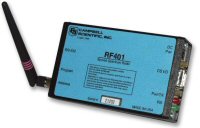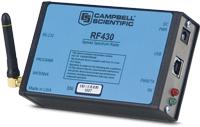RF401 900-MHz Spread-Spectrum Radio
The RF401 Spread Spectrum Radio has a 910 to 918 MHz operating frequency range, which is allocated to the US and Canada. Spread spectrum radios spread the normally narrowband information signal over a relatively wide band of frequencies. This improves communication performance in locations where RF noise, pagers, cellular phones and multipath could cause interfence. The RF401 reduces susceptibility to RF interference from similar spread spectrum devices by providing user-selectable frequency hopping patterns.
The RF401 spread spectrum radio modem supports point-to-point and point-to-multipoint datalogger communications. It can serve as a field modem/radio while connected to the datalogger or as a base station modem/radio when connected to a computer. The RF401 modem can also be used for general purpose wireless data communications.

Features
Replaces our RF400 Spread Spectrum Radio
Rugged, low-cost transceivers
100 mW, 910 to 918 MHz frequency
Frequency-hops over 25 channels
An individual FCC license not required
Can be used in the field as a transceiver or in the office as the base station
Power provided by datalogger, PS100/A100 combination, or CH100/12Vdc battery, depending upon application
Transmits up to one mile with omni-directional antenna; up to 10 miles with higher gain directional antennas
Designed for use in PakBus networks
Settings stored in non-volatile memory
Optional extended temperature testing
Specifications
Operating Frequency: 910 to 918 MHz
Type: Frequency Hopping Spread Spectrum (FHSS) Transceiver
I/O Data Rate: 38.4 K, 19.2 K, 9600, 4800, or 1200 bps
Channel Capacity: 65,000 Network Identifiers share 25 hop channels
Frequency Hopping Patterns: Six different selectable patterns
Receiver Sensitivity: -110 dBm at 10-4 bit error rate (Campbell Scientific protocols will issue retries wherever a bit error occurs)
Interference Rejection: 70 dB at pager and cellular phone frequencies
Transmitter Power Output: 100 mW nominal
Antenna Connector: Reverse polarity SMA
FCC ID: OUR9XTREAM
Power: 9 to 16 Vdc
Average Current Drain
Stand-by: <1 mA (power-saving options used)
Receiving: 24 mA
Transmitting: <75 mA
LEDs: Power on, TX, RX, diagnostics
RS-232 Connector: 9-pin “D” Female (4 wire: Tx, Rx, CTS, GND)
CS I/O Connector: 9-pin “D” Male (newer dataloggers provide power to the radio on this connector. Dataloggers purchased before December 1997 require the #14291 Field Power Cable.)
Power Connector: Barrel plug, center positive 12 V; used to connect the 14291 Field Power Cable
RF430 900-MHz Spread-Spectrum Radio
The RF430, RF431, and RF432 radio modems are functionally the same as the RF401, RF411, and RF416 models, except for a change to their ports. The RF430-series radios have a USB port instead of the CS I/O port that the RF401-series radios have. The USB port makes it easier to connect to newer computers, and the RS-232 port still allows them to be connected to our current dataloggers. Networks can include a mix of the RF430-series and RF401-series radios.
The RF430 spread-spectrum radio has a 910- to 918-MHz operating frequency range, which is used in America and Canada. Spread-spectrum radios spread the normally narrowband information signal over a relatively wide band of frequencies. This improves communication performance in locations where RF noise, pagers, cellular phones and multipath could cause interfence. The RF430 reduces susceptibility to RF interference from similar spread-spectrum devices by providing user-selectable frequency hopping patterns.
The RF430 supports point-to-point and point-to-multipoint datalogger communications. It can serve as a field modem/radio while connected to the datalogger or as a base station modem/radio when connected to a computer. The RF430 modem can also be used for general-purpose wireless data communications.

Features
Equivalent to RF401, but with USB port instead of CS I/O port
Rugged, low-cost transceivers
100 mW, 910 to 918 MHz frequency
Frequency-hops over 25 channels
An individual FCC license not required
Can be used in the field as a transceiver or in the office as the base station
Power provided by datalogger, PS100/A100 combination, or CH100/12Vdc battery, depending upon application
Transmits up to one mile with omni-directional antenna; up to 10 miles with higher gain directional antennas
Designed for use in PakBus networks
Settings stored in non-volatile memory
Optional extended temperature testing
Specifications
Operating Frequency: 910 to 918 MHz
Type: Frequency Hopping Spread Spectrum (FHSS) Transceiver
I/O Data Rate: 38.4 K, 19.2 K, 9600, 4800, or 1200 bps
Channel Capacity: 65,000 Network Identifiers share 25 hop channels
Frequency Hopping Patterns: Six different selectable patterns
Receiver Sensitivity: -110 dBm at 10-4 bit error rate (Campbell Scientific protocols will issue retries wherever a bit error occurs)
Interference Rejection: 70 dB at pager and cellular phone frequencies
Transmitter Power Output: 100 mW nominal
Antenna Connector: Reverse polarity SMA
FCC ID: OUR9XTREAM
Power: 9 to 16 Vdc
Average Current Drain
Stand-by: <1 mA (power-saving options used)
Receiving: 26 mA
Transmitting: 78 mA
LEDs: Power on, TX, RX, diagnostics
RS-232 Connector: 9-pin “D” Female (4 wire: Tx, Rx, CTS, GND)
Power Connector: Barrel plug, center positive 12 V; used to connect the 14291 Field Power Cable
Producing Area:USA